Every year, Dentsu conducts a global consumer survey of the brand “Japan,” to assist Japanese companies that are involved in inbound tourism or do business internationally. Findings of the poll, based on the latest results of the survey conducted in fiscal 2017 (ending on December 31, 2017), may be useful in the future for businesses that cater to foreign tourists. These findings are presented below.
The Dentsu Japan Brand Survey was conducted in the following 20 countries and regions: China (the three largest cities of Beijing, Shanghai and Guangzhou; and the growing regional cities of Shenzhen, Tianjin, Chongqing, Suzhou, Wuhan, Chengdu, Hangzhou, Dalian, Xian and Qingdao); Hong Kong; Taiwan; South Korea; India; Singapore; Thailand; Indonesia; Malaysia; Vietnam; the Philippines; Australia; the United States; Canada; Brazil; England; France; Germany; Italy; and Russia.
The sample comprised 4,400 people, with the respondents targeted being middle-class men and women between the ages of 20 and 59. In addition to the 300 respondents in the United States and China respectively, there were 200 respondents in each of the other countries and regions polled. The survey was conducted online during February and March 2017.
Which parts of the world had the most desire to visit Japan?
Almost 80% of all the survey respondents indicated that they either wanted, or had plans, to visit Japan. The desire to visit Japan was particularly high among Southeast Asian countries, with over 90% of respondents in each of those nations surveyed expressing an intention to visit. Thus, growing numbers of Southeast Asian tourists can be expected in the future. (Chart 1)

Meanwhile, among the Western countries surveyed, the desire to visit Japan ranged between 60% and 70%. While the ratio is by no means low, the countries that these respondents most wanted to visit tended to be other Western countries. Japan was the most wanted to visit country among Asian respondents however, it placed third or fourth among respondents in other parts of the world. (Chart 2)
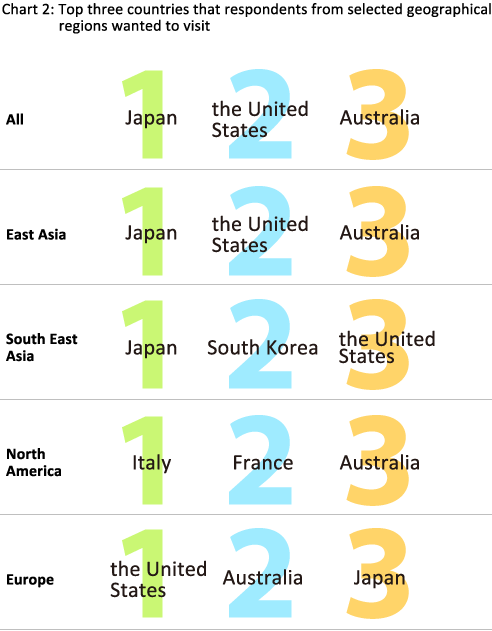
Things in Japan that respondents were interested in
Among many Western countries, the three things in Japan that respondents were most interested in were Japanese food, traditional Japanese gardens, and Japanese shrines and temples. Each year, survey respondents from these countries have increasingly expressed interest in, and appreciation of, aspects of Japanese culture, especially the nation’s food. These aspects even act as triggers to visit to Japan. In light of those findings, businesses that use aspects of Japanese culture to attract Western tourists have solid prospects for success. (chart 3)
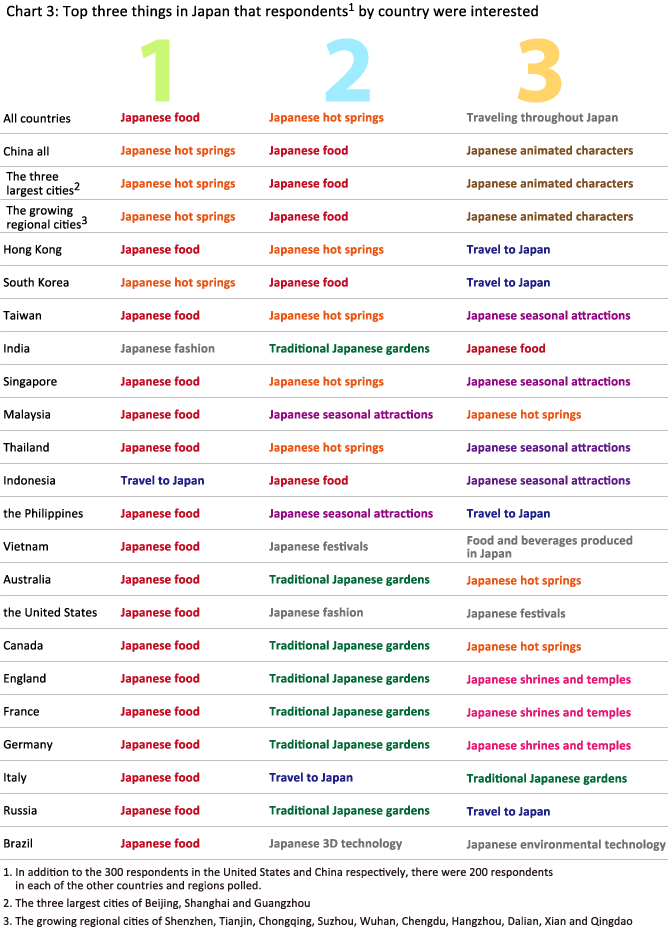
Desired vacation styles in Japan
In response to a survey question about desired vacation styles in Japan, Asian and European respondents tended to give different answers from North America respondents. A desire to visit major tourist attractions was the top response among many in the Asian and European countries surveyed, whereas a desire to follow fads popular with Japanese was the top response among pollees in the North American countries. (Chart 4)

Responses to a question concerning the activities in which respondents want to take part while in Japan also tended to differ. To eat Japanese food and visit natural sightseeing spots commonly ranked among the top two responses in many of the countries and regions surveyed.
Other activities were varied by geographical region. The highest-ranking responses for East Asian countries, Singapore and Thailand were shopping and bathing in hot springs. For Malaysia and the Philippines, it was experiencing seasonal attractions, while visiting historic sites and buildings was among the top desired activity for several Western countries.(Chart 5)
These results indicate that tailoring advertising campaigns to specific countries and regions is important for attracting tourists to Japan.
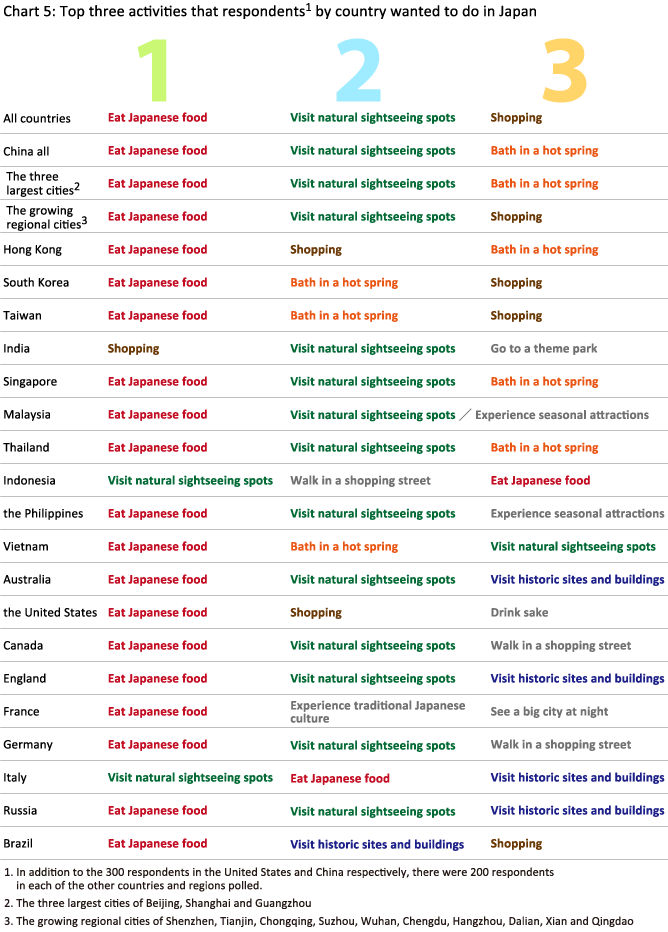
What trends can be expected in the future?
Scenes of Chinese tourists on shopping sprees that have attracted attention in recent years are now less common. This is because the reasons for which they come to Japan have been shifting from products to services.
In this survey, among respondents from China’s three largest cities of Beijing, Shanghai, and Guangzhou (the main source of that country’s tourists), Japan ranked second as the country they most wanted to visit, and shopping was not included among the top three things they wanted to do in Japan. Instead, eating Japanese food, visiting natural sightseeing spots and bathing in a hot spring had emerged to be the three most popular activities from those cities. (Chart 6)
By comparison, respondents from China’s growing regional cities have indicated that Japan is the country they most want to visit and shopping is their third-most desired activity. (Chart 7)
As the source of Chinese tourists shifts from the three largest cities to regional cities, Japan is likely to see another wave of shopping sprees.
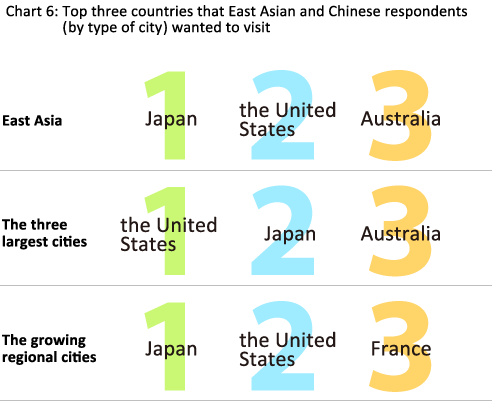
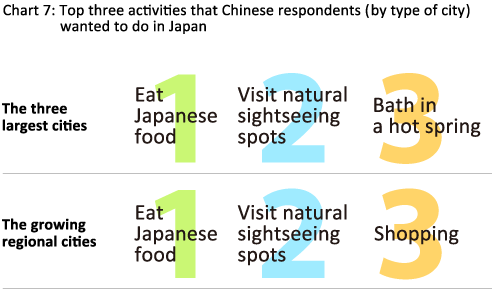
Although only a small portion of the survey results have been covered here, they show that new trends are emerging, and that the needs of tourists differ according to their country of origin.
Thus if Japan, with its diverse regions and four distinct seasons, effectively tailors the marketing of its many attractions to meet the different needs of tourists, it should be able to attract an even greater number of visitors than at present.
